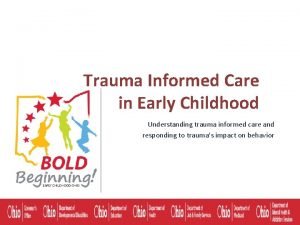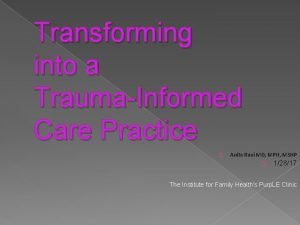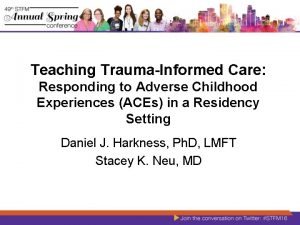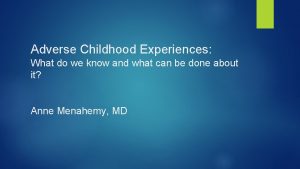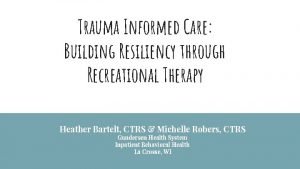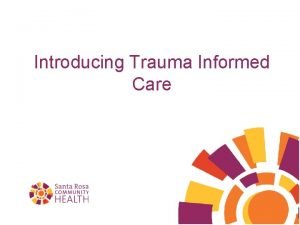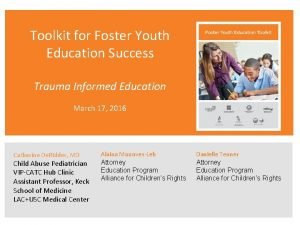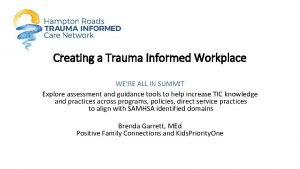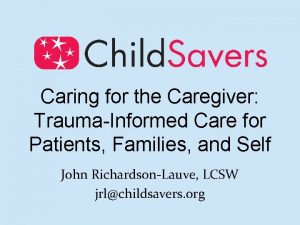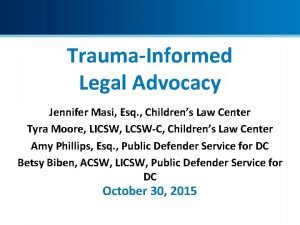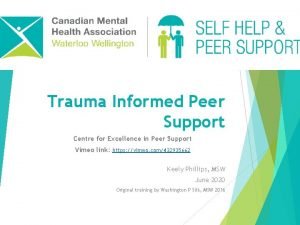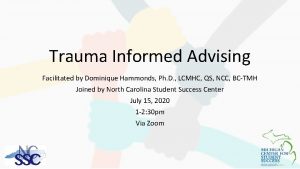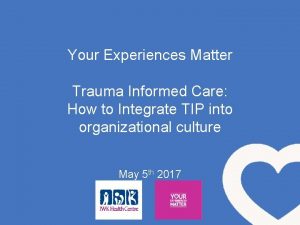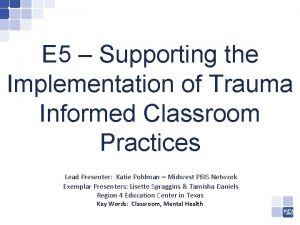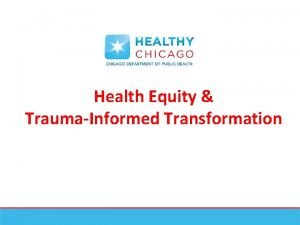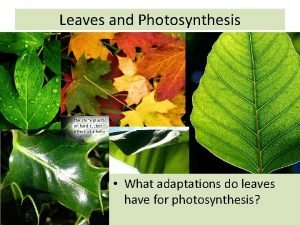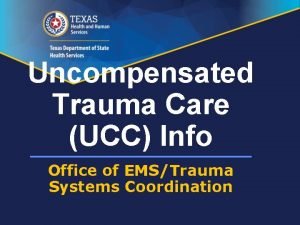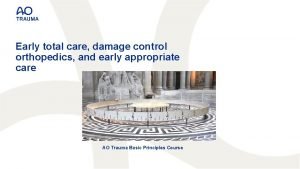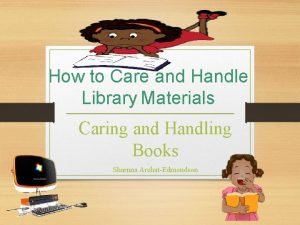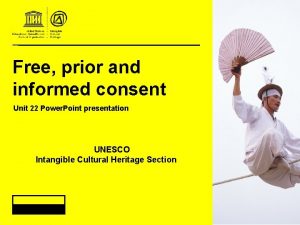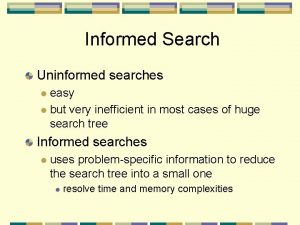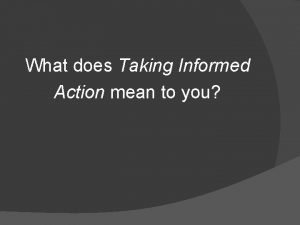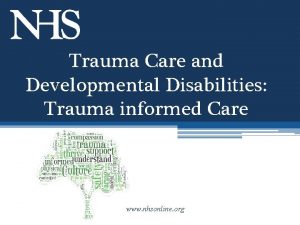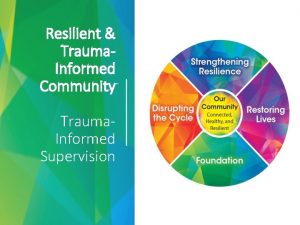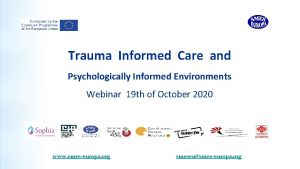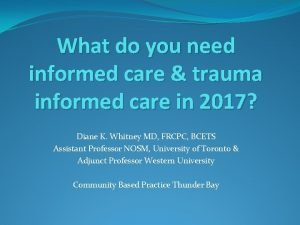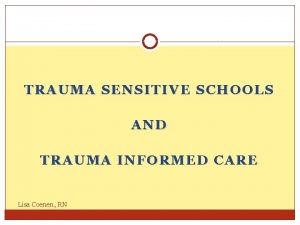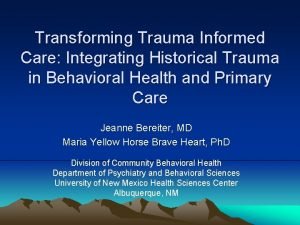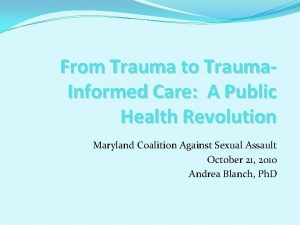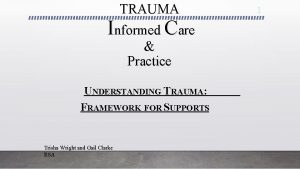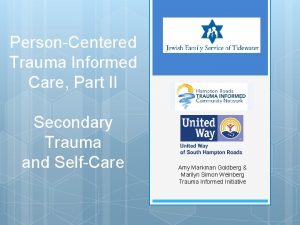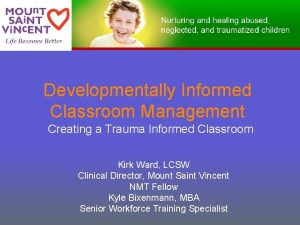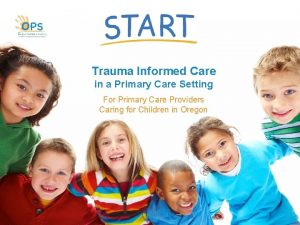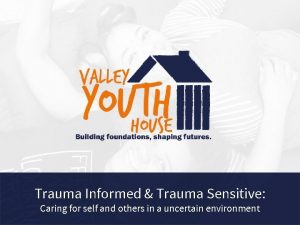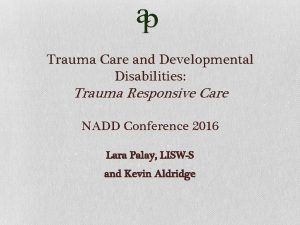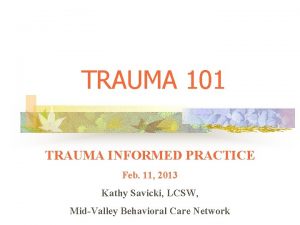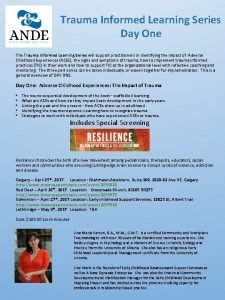Trauma and Trauma Informed Care Methodology Required Materials





































- Slides: 37

Trauma and Trauma Informed Care

Methodology: Required Materials: Active discussion Easel Pad Case Study Role Play Participant Manual Notepad for each participant Pens & Pencils Duration: 6 hours TRAUMA AND TRAUMA INFORMED CARE

TRAUMA AND TRAUMA INFORMED CARE Learning Objectives • To define and conceptualize the nature of trauma. • To learn about the Adverse Childhood Experiences (ACE) Study. • To understand the neurological response to trauma. • To understand the link between trauma and addictions.

TRAUMA AND TRAUMA INFORMED CARE Learning Objectives continued… • To conceptualize trauma informed care approach. • To learn and practice trauma informed care skills when working with youth. • To integrate trauma informed care approaches within service institutions.

OVERVIEW OF TRAUMA

PROCESSING… • What did you notice about the group’s answers? • Unique interpretation of event(s) • Doesn’t have to happen to you

HIERARCHY OF TRAUMA • In small groups, examine the index cards given to you and decide how traumatic each event is using a scale of 1 -20 (with 20 being the most severe and 1 being the least). • Tape the index card where you feel appropriate on the scale on the white board.

DEFININING TRAUMA Individual trauma results from an event, series of events, or set of circumstances experienced by an individual as physically or emotionally harmful or life-threatening with lasting adverse effects on the individual’s functioning and mental, physical, social, emotional, or spiritual well-being. (SAMHSA, 2020)

GENDER DIFFERENCES Male ◦ More likely to experience a potential traumatic event ◦ More likely to report physical violence by strangers ◦ More likely to experience trauma in childhood Female ◦ ◦ Two times more likely to be diagnosed with Post Traumatic Stress Disorder (PTSD) More likely to report interpersonal physical or sexual abuse More likely to experience more severe potential traumatic events Likely to experience trauma from at any time from childhood throughout adulthood (Tolin & Foa, 2006)

ADVERSE CHILDHOOD EXPERIENCES (ACE) STUDY (CDC, 2019; SAMHSA, 2020)

ACE STUDY • About the Survey: • Measured three main areas related to childhood trauma. • Abuse, Neglect and Household Dysfunction • Self-awareness exercise • See appendix resource to find the ACE Survey (CDC, 2019; SAMHSA, 2020)

ACE STUDY RESULTS The study found that: • childhood trauma was very common, even in employed white middle-class, collegeeducated people with great health insurance; • there was a direct link between childhood trauma and adult onset of chronic disease, as well as depression, suicide, being violent and a victim of violence; • more types of trauma increased the risk of health, social and emotional problems. • people usually experience more than one type of trauma – rarely is it only sex abuse or only verbal abuse. (CDC, 2019; SAMHSA, 2020)

ACE RESULTS RELATED TO SUBSTANCE USE/ABUSE • Alcoholism and alcohol abuse • Chronic obstructive pulmonary disease §Depression §Fetal death §Health-related quality of life §Illicit drug use §Ischemic heart disease (IHD) §Liver disease §Risk for intimate partner violence • Multiple sexual partners • Sexually transmitted diseases (STDs) • Smoking • Suicide attempts • Unintended pregnancies • Early initiation of smoking • Early initiation of sexual activity • Adolescent pregnancy

(CDC, 2019; SAMHSA, 2020)

TRAUMATIC EXPEREINCES AROUND THE WORLD

WORLD HEALTH ORGANIZATION WORLD MENTAL HEALTH SURVEY The WHO World Mental Health Survey was conducted in the following regions of the world: ◦ ◦ ◦ The Americas South-East Asia Europe Africa Eastern Mediterranean The Western Pacific (WHO, 2008)

WORLD HEALTH ORGANIZATION WORLD MENTAL HEALTH SURVEY FINDINGS • 70. 3% prevalence of lifetime traumatic experience exposure. • On average, participants reported at least 4. 5 traumatic experiences. • Of the traumatic experiences reported: • 27. 1% were community violence-related • 25% were accidents & illnesses • 20. 4% were related to organized violence • 14. 7% included rape and domestic violence • 8. 4% included physical violence by a caregiver as a child or witnessing domestic abuse. (WHO, 2008)

TRAUMA & THE BRAIN

THE EMOTIONAL BRAIN Important brain structures: • The Amygdala • Prefrontal Cortex

THE BRAIN’S REPOSNSE TO TRAUMA Amygdala Detects Situation of danger Sympathetic Nervous System Activates Stress hormones released Bodily reactions Prolonged state of alarm (Campbell, 2019)

TRAUMA REACTIONS (Campbell, 2019)

TRAUMA & ADDICTIONS Adolescents with as history of early trauma are more likely to be addicted to substances, and display the following: • Engage in risk-taking behaviors • Be more impulsive • Have boundary issues • Distrust others • Low self-esteem • Difficulty relating to others • Display irritability/hostility

STRESS DISORDERS • Stress disorders are a cluster of diagnoses that differentiate different types of reactions individuals can experience resulting from trauma. • International Classification of Diseases (ICD) Definitions • Adjustment Disorder • Post-Traumatic Stress Disorder • Complex Post-Traumatic Stress Disorder (ICD, 2020)

ADJUSTMEN T DISORDER (ICD, 2020)

POST-TRAUMATIC STRESS DISORDER (PTSD) • Re-experiencing • Avoidance • Hypervigilance • Impairment in major life aspect (ICD, 2020)

COMPLEX POST TRAUMATIC STRESS DISORDER (CPTSD) • All individuals with CPTSD meet criteria for PTSD as well. • Additional symptoms include: • Affect Regulation • Negative Self-concept • Interpersonal disturbances (ICD, 2020)

SYMPTOMS = ADAPTATIONS • Individuals react differently to trauma and may experience a range of physical and/or emotional reactions. • There is no “right” or “wrong” way to react to trauma. • Human responses are normal reactions to abnormal events.

TRAUMA INFORMED CARE (TIC)

TRAUMA INFORMED CARE A program, organization, or system that is trauma-informed: • Realizes the widespread impact of trauma and understands potential paths for recovery; • Recognizes the signs and symptoms of trauma in clients, families, staff, and others involved with the system; • Responds by fully integrating knowledge about trauma into policies, procedures, and practices; and • Seeks to actively resist re-traumatization (SAMHSA, 2014)

TRAUMA INFORMED CARE • A culture change • A multidimensional, systems approach to dealing with histories of trauma • Taking steps to make sure every part of the organization, management, and service delivery system is assessed and potentially modified to include a basic understanding of how trauma affects the life of an individual seeking services (SAMHSA, 2014)

TRAUMA INFORMED CARE TIC is a universal precautions approach that is designed to be both preventative and rehabilitative in nature. It address the relationship between environmental or subjective triggers, the perception of danger, and the neurobiological activation that leads to a distressed physical state and resulting in problematic behavior. (Harris & Fallot, 2001; NASMHPD, 2010 )

Key Concept: Trauma-informed Care • Safety • Trustworthiness • Peer Support • Collaboration • Empowerment, Voice, Choice • Cultural, Historical and Gender Issues (SAMHSA, 2014)

Diversity is complex and varies across countries Let’s do an exercise!

EXAMPLES OF TRAUMA INFORMED LANGUAGE NOT TRAUMA INFORMED “Youth is resistant to treatment” “Youth is struggling to cope with abstinence” “Youth is disrespectful to staff” “Youth does not feel safe in the space” “Youth lies about the use of substances” “Youth is working through ambiguity of substance use” “Youth is not engaged in treatment plan” “Youth needs adaptation to treatment plan to meet them where they’re at” “Youth plays the victim” “Youth is letting me know their previous coping styles to being held accountable” “The family is unwilling to heal” “The family requires multiple interventions for their needs”

Smart Tips for Building and Utilizing a Trauma -Informed Lens in Your Task Force • Review agency policies and procedures to identify and remove any that are potentially unsafe and harmful to trafficking victims with histories of trauma. • Provide education and training of staff, including those working directly with trafficking victims as well as other providers in relevant systems of care. • Screen for trauma in multiple settings. (Clawson, Salomon & Goldbatt, 2008)

• Ensure safety and meet basic service needs. • Build long-term, sustaining relationships and provide opportunities for regaining valued social roles. • Provide access to trauma-specific treatment services. • Specific to adolescents, use group therapy to address skills development, affect regulation, interpersonal connections, and competence and resiliency building. • Understand the role that culture plays in resiliency and the importance of community resources as potentially mediating the trauma experience, particularly foreign-born victims. (Clawson, Salomon & Goldbatt, 2008)

• Make peer models and supports available. • Engage survivors in programming. • Develop alternatives to traditional therapies. (Clawson, Salomon & Goldbatt, 2008)
 4 r's trauma informed care
4 r's trauma informed care Lgbtq trauma informed care
Lgbtq trauma informed care 4 r's trauma informed care
4 r's trauma informed care 4 r's trauma informed care
4 r's trauma informed care 4 r's trauma informed care
4 r's trauma informed care Www.dfps.state.tx.us/training/trauma informed care/
Www.dfps.state.tx.us/training/trauma informed care/ Tina champagne trauma informed care
Tina champagne trauma informed care Trauma informed practice
Trauma informed practice Trauma-informed care activities for staff
Trauma-informed care activities for staff Trauma informed care for foster youth
Trauma informed care for foster youth Trauma-informed workplace assessment
Trauma-informed workplace assessment Trauma-informed questions for clients
Trauma-informed questions for clients Trauma informed legal advocacy
Trauma informed legal advocacy Kobtion
Kobtion Trauma informed advising
Trauma informed advising Trauma informed parenting discipline
Trauma informed parenting discipline Trauma informed practice
Trauma informed practice Trauma informed physical environment
Trauma informed physical environment Trauma informed practice
Trauma informed practice List of materials required for building construction
List of materials required for building construction Section through a leaf
Section through a leaf Write the materials required to conduct oersted experiment
Write the materials required to conduct oersted experiment Levels of care primary secondary tertiary quaternary
Levels of care primary secondary tertiary quaternary Favourite cars
Favourite cars Harmful and useful materials at home
Harmful and useful materials at home Man made materials
Man made materials Adapting and adopting materials
Adapting and adopting materials Dshs uncompensated trauma care application
Dshs uncompensated trauma care application Total care orthopedics
Total care orthopedics Direct materials budget with multiple materials
Direct materials budget with multiple materials Care and handling of library materials
Care and handling of library materials Free prior and informed consent
Free prior and informed consent What is informed search and uninformed search
What is informed search and uninformed search Uninformed search examples
Uninformed search examples Uninformed and informed search
Uninformed and informed search Health and social care values unit 2
Health and social care values unit 2 What is informed action
What is informed action Parents promoters apathetics defenders
Parents promoters apathetics defenders
